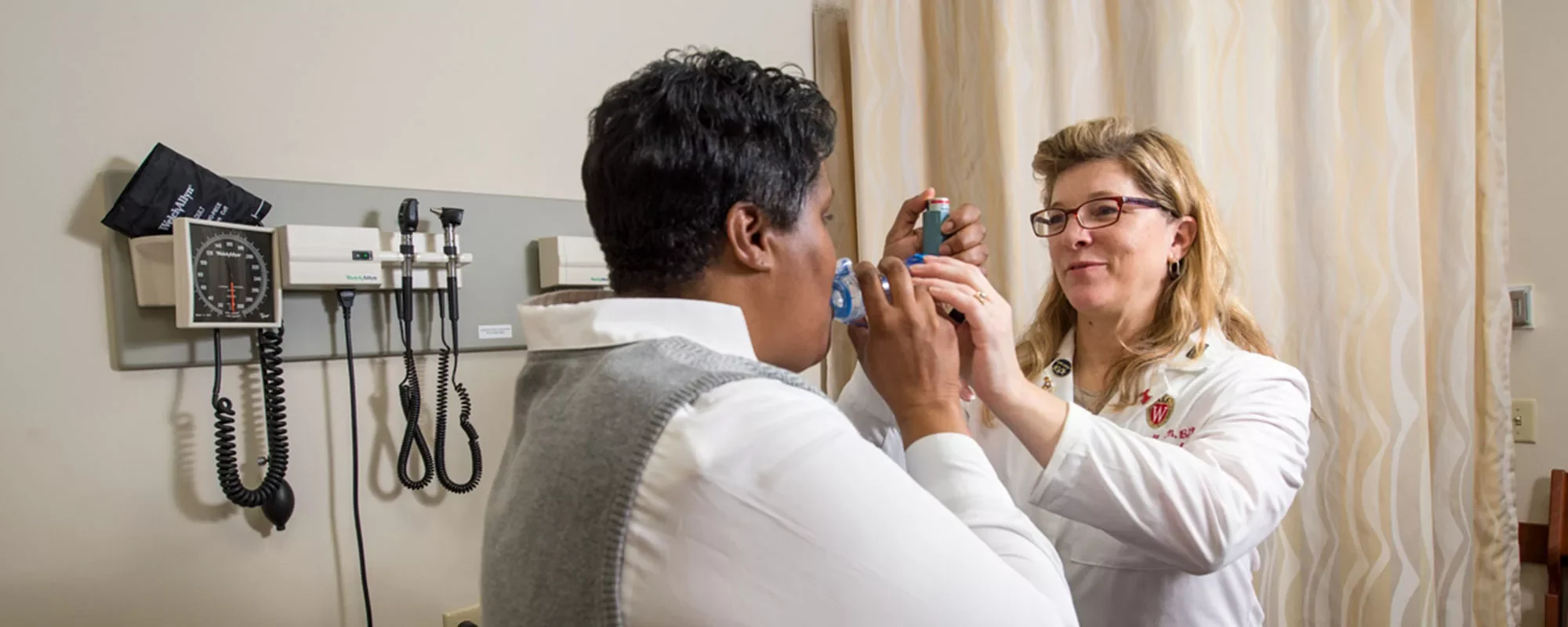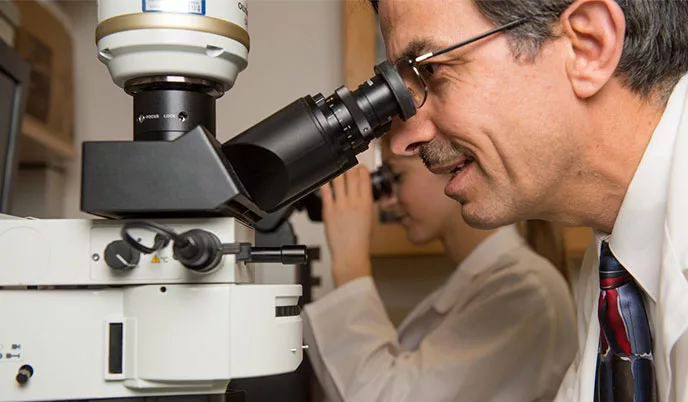Making a Difference
When Susan Isensee, MD ’83 (PG ’86), was named the 50th president of the Wisconsin Medical Alumni Association (WMAA) on July 1, 2016, she knew just what she would do with her two-year appointment.

When I started caring for asthma patients, children and adults with this condition didn’t do physical activity. Students got doctors’ notes to sit out of physical education classes,” recalls William Busse, MD ’66, who began his medical career in allergy at a military hospital near Seattle in the late 1960s.
With few effective therapeutic options for asthma available then, physicians recommended against exercise because the risk of an asthma attack was almost unavoidable, explains Busse, a professor in the Department of Medicine’s Division of Allergy, Pulmonary and Critical Care Medicine at the University of Wisconsin School of Medicine and Public Health.
Today, everything has changed. “With the effective asthma treatment we have today, the vast majority of people with asthma can and do live more normal lives. They enjoy playing sports and go to school and work, hopefully without thinking about their asthma,” says Mark Moss, MD (PG ’00), an associate professor in the same division.
This success story spans more than four decades and involves hundreds of UW-Madison faculty and staff, and thousands of patients nationwide. And it continues to evolve in unexpected ways.
“You’d be surprised how far Wisconsin’s influence reaches. Anytime you write a review of asthma, you ‘virtually’ pass through Madison multiple times,” notes Nizar Jarjour, MD, head of the Division of Allergy, Pulmonary and Critical Care Medicine in the Department of Medicine.
Recalling his internal medicine residency in Chicago, Jarjour shares, “Many patients came to the emergency room with bad asthma exacerbations — it was scary for them.”
As a pulmonary fellow at UW Health, Jarjour wanted to understand the disease better by observing events directly in the lungs during asthma attacks, despite having no prior formal research training. Encouraged by Busse and former faculty member William Calhoun, MD (PG ’92), Jarjour obtained funding from the Department of Medicine for a small study.
In the laboratory, he had subjects with asthma run on treadmills, and he immediately collected samples of their airway by doing a bronchoscopy and lavage after tending to their bronchospasms, so he could examine what was happening with their lung cells. Jarjour relished that opportunity and has extended this investigation to study the role of viruses, allergies and sleep in asthma.
When he became a UW School of Medicine and Public Health faculty member in 1990 after his fellowship, Jarjour joined a convergence of asthma-focused faculty members, many of whom also were mentored by Busse.
“Robert Lemanske [MD ’75 (PG ’80)] brought a focus on pediatric asthma, an important step as that is when the disease begins,” explains Busse. “And James Gern (MD), a pediatric allergist and virologist, knew how to use new molecular approaches to study respiratory viruses involved in making asthma worse — another major step forward.”
All continue to make great asthma-related strides at the UW School of Medicine and Public Health, along with several others, including:
Additionally, Ann Palmenberg, PhD, professor of biochemistry, and John Yin, PhD, professor of chemical and biological engineering — of the College of Agricultural and Life Sciences and Engineering, respectively — and other basic scientists throughout UW-Madison collaborate on asthma cell biology, virology and molecular biology studies.
“We are fortunate that basic scientists and clinical faculty members often combine forces, and so many individuals have a shared interest and enthusiasm,” shares Busse. “UW-Madison is particularly receptive to multidisciplinary collaboration.”
This collaborative approach has resulted in a long history of multi-investigator grants, says Jarjour, adding, “We were doing team science before the word was fashionable.”
Here, it’s not just research for the sake of doing the next study. Our research has a direct impact on clinical care.
- Mark Moss
Over the years, the team has been enriched with investigators from various disciplines, including Deane Mosher, MD, professor, Departments of Medicine and Biomolecular Chemistry; Paul Bertics, PhD, former professor, Department of Biomolecular Chemistry; Thomas Grist, MD, professor, Department of Radiology; Sean Fain, PhD, Department of Medical Physics; James Malter, MD, Department of Pathology; and Ron Sorkness, PhD ’86, RPh, professor, Departments of Medicine and Pediatrics, UW School of Medicine and Public Health, and professor, School of Pharmacy.
The approach has been productive. Based on publications since 2006, UW-Madison is the top-ranked public university in the United States for asthma research and the fifth-place institution in the world, according to research analytics firm Expertscape.
For example, the NIH’s National Institute of Allergy and Infectious Diseases recently awarded the UW School of Medicine and Public Health a seven-year, $70 million grant for its continuing work on the Inner-City Asthma Consortium (ICAC). The grant is the largest ever received by the UW School of Medicine and Public Health, with ICAC’s total amount of NIH funding since 2002 at just over $190 million.
Another large-scale, NIH-funded study, Childhood Origins of ASThma (COAST), is investigating the origins of childhood asthma. This prospective study enrolls children prior to their birth and follows them, their respiratory illnesses and the development of wheezing illnesses until age 8, explains Lemanske. Multiple related projects have extended COAST and/or called upon its findings.
From the beginning, UW School of Medicine and Public Health asthma experts integrated research and patient care. “Here, it’s not just research for the sake of doing the next study. Our research has a direct impact on clinical care,” notes Moss.
Because UW School of Medicine and Public Health investigators have day-to-day experience in both the laboratory and clinical settings, pharmaceutical companies often seek their advice on new therapies. From the introduction of inhaled steroids to immunoglobulin E (IgE)-targeted biologics, UW School of Medicine and Public Health researchers have been involved in clinical testing of every asthma medication developed in recent decades.
“Since the 1980s, our clinical research unit has evaluated new asthma medications, including efforts to learn how each drug works best and in which patients the treatment will be most effective,” says Busse.
UW School of Medicine and Public Health researchers recognized that the presence or absence of animals, microbes, insects and even inanimate viruses in a person’s surroundings, particularly during youth, dictate whether — and how much — they will suffer from asthma. Additionally, UW School of Medicine and Public Health investigators were among the first to link respiratory infections and asthma.
Busse’s mentor — Charles E. Reed, MD, former faculty member and head, Division of Allergy and Immunology — conducted studies that suggested the common cold virus could contribute to asthma attacks. Busse found this fascinating.
He explains, “Everybody gets colds, but the question was, ‘How could an innocuous respiratory virus bring about such profound changes in asthma?’”
In 1989, Busse and Lemanske published a study in which volunteers with mild asthma were exposed to a rhinovirus strain. They were stunned by the results: not only did some asthma patients have a significant inflammatory response to an inhaled allergen, but the virus caused abnormalities in their airways that lasted up to six weeks.
“Viruses made the allergic disease worse,” explains Busse.
In the inner city, though, we found that the more cockroach, mouse and cat allergens these little kids were exposed to, the better their respiratory outcomes. We couldn’t believe it.
- James Gern
These findings launched a series of studies to identify which rhinoviruses were most important, work that led Gern to identify rhinovirus A and C as key factors shaping respiratory health in asthma-susceptible individuals. To understand the interplay between immune responses and asthma, he and colleagues investigated the influence of microbial and animal-derived allergens on cohorts of children raised in inner-city, suburban or rural settings.
One of Gern’s most surprising findings came from sampling vacuum cleaner dust collected from inner-city homes and correlating allergens with asthma in children. Studies on children raised on farms indicated that growing up around dogs or livestock led to lower rates of asthma.
“In the inner city, though, we found that the more cockroach, mouse and cat allergens these little kids were exposed to, the better their respiratory outcomes. We couldn’t believe it,” exclaims Gern.
Researchers knew that children with asthma who were allergic to cockroach allergens often had severe exacerbations. But the idea that exposure in the absence of an allergy could be protective turned conventional wisdom on its head.
“Obviously, we’re not advocating that kids should have more exposure to cockroaches, but we need to learn how those exposures lead to better health,” notes Gern.
Today, Jackson wants to use this knowledge to nudge patients’ immune systems toward preventing asthma. In one clinical trial, he is investigating whether giving children a bacterial extract, which is sold over the counter in Europe, can help prevent patients from developing severe respiratory illnesses. In another, he administers, to 2- and 3-year-old children at risk for asthma, a biologic medication that binds IgE to see if dampening a hyperactive immune system will be protective.
“Studies have identified modifiable risk factors for asthma development, and we want to apply this knowledge to prevent disease,” says Jackson.
Gern envisions a day when providers are able to test for a biomarker in children at risk for asthma and make recommendations based on the outcome. Could it involve a prescription for a pet — to the delight of children everywhere?
Laughing at the possibility of interventions measured in dog units, Gern adds, “We hope to learn what’s good about being on a farm, for example, and to be able to bring the benefits of a farm lifestyle to children who grow up in suburban and city environments.”
After making numerous significant contributions to overall knowledge about asthma and effective treatments, the team is looking to the future. Gern explains that the potential for effective prevention techniques reaches beyond asthma, toward other respiratory conditions.
“A lot of respiratory diseases in adults start early in life. By learning how we can promote good respiratory health at a young age, it’s likely that we can improve health not only in kids but into the sixth, seventh and eighth decades of life,” he notes.
Another urgent need is to develop treatments for severe asthma. For a subset of patients, even the most advanced medicines inadequately control their disease.
“We still don’t have a deep understanding of the mechanisms that drive their asthma,” explains Moss. “It will take the next era of research to understand that.”

True to character, UW School of Medicine and Public Health researchers are continuing to explore new territory.
For instance, in September 2016, UW-Madison received a two-year, $15 million NIH grant to establish and oversee a new Children’s Respiratory Research and Environment Workgroup (CREW) — a national consortium of 14 institutions, including the UW School of Medicine and Public Health, that will study how genetics interact with environmental exposures during the prenatal and early childhood years to cause specific subtypes of childhood asthma. Gern is the CREW principal investigator, and the grant is part of $157 million in awards by the NIH that launch a national, seven-year initiative called Environmental Influences on Child Health Outcomes.
Also, nearly 40 years after being awarded his first extramural research grant, Busse is starting an entirely new line of investigation. He and Richard Davidson, PhD, are partnering on a psychoneuroimmunology study that will investigate the signaling mechanisms between the brain and lungs that influence asthma disease processes. Internationally recognized for his expertise in mind-body connections, Davidson is the Vilas Professor of Psychology and Psychiatry. The NIH-funded work could help researchers understand the influence of emotional states, such as stress and depression, on asthma.
“This field of study has implications for developing new ways to intervene with asthma,” says Busse — leaving open the possibility of prescriptions measured in units of Zen.